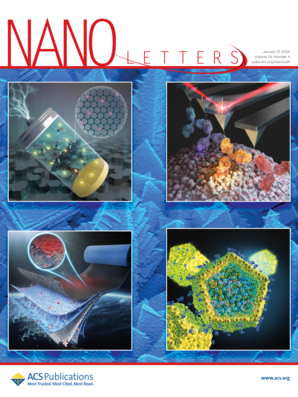Modulating Hole Transfer from CdSe Quantum Dots by Manipulating the Surface Ligand Density
IF 9.1
1区 材料科学
Q1 CHEMISTRY, MULTIDISCIPLINARY
引用次数: 0
Abstract
The structure and density of surface capping ligands in cadmium chalcogenide quantum dots (QDs) are important considerations for controlling the efficiency of charge separation via the transfer of electrons or holes to molecular acceptors. Here we show how the manipulation of the surface ligand density of oleic acid-capped cadmium selenide (CdSe) QDs impacts the efficiency of hole transfer (HT) to polyoxovanadate alkoxides. Meerwein’s salt is used as a ligand-stripping agent, providing opportunities to quantitatively manipulate the ligand density at the surface of the nanocrystal, as evidenced by 1H NMR spectroscopy. Time-resolved photoluminescence and transient absorption spectroscopies reveal that the extent of HT is quantitatively related to increased surface accessibility. Collectively, these results show that the reduction of surface ligand density can be used to tune the extent of interactions of molecular acceptors with QDs, providing a route to control charge-transfer processes relevant to improving the efficiency of QDs as photosensitizers.

利用表面配体密度调制CdSe量子点的空穴转移
镉硫系量子点(QDs)表面盖层配体的结构和密度是控制电子或空穴向分子受体转移的电荷分离效率的重要因素。在这里,我们展示了油酸覆盖的硒化镉(CdSe)量子点的表面配体密度如何影响到多氧钒酸盐醇氧化物的空穴转移(HT)效率。Meerwein盐被用作配体剥离剂,提供了定量操纵纳米晶体表面配体密度的机会,如1H NMR波谱所证明的那样。时间分辨光致发光和瞬态吸收光谱显示,高温的程度与增加的表面可及性在数量上有关。总的来说,这些结果表明,表面配体密度的降低可以用来调节分子受体与量子点的相互作用程度,为控制与提高量子点作为光敏剂效率相关的电荷转移过程提供了一条途径。
本文章由计算机程序翻译,如有差异,请以英文原文为准。
求助全文
约1分钟内获得全文
求助全文
来源期刊

Nano Letters
工程技术-材料科学:综合
CiteScore
16.80
自引率
2.80%
发文量
1182
审稿时长
1.4 months
期刊介绍:
Nano Letters serves as a dynamic platform for promptly disseminating original results in fundamental, applied, and emerging research across all facets of nanoscience and nanotechnology. A pivotal criterion for inclusion within Nano Letters is the convergence of at least two different areas or disciplines, ensuring a rich interdisciplinary scope. The journal is dedicated to fostering exploration in diverse areas, including:
- Experimental and theoretical findings on physical, chemical, and biological phenomena at the nanoscale
- Synthesis, characterization, and processing of organic, inorganic, polymer, and hybrid nanomaterials through physical, chemical, and biological methodologies
- Modeling and simulation of synthetic, assembly, and interaction processes
- Realization of integrated nanostructures and nano-engineered devices exhibiting advanced performance
- Applications of nanoscale materials in living and environmental systems
Nano Letters is committed to advancing and showcasing groundbreaking research that intersects various domains, fostering innovation and collaboration in the ever-evolving field of nanoscience and nanotechnology.
 求助内容:
求助内容: 应助结果提醒方式:
应助结果提醒方式:


